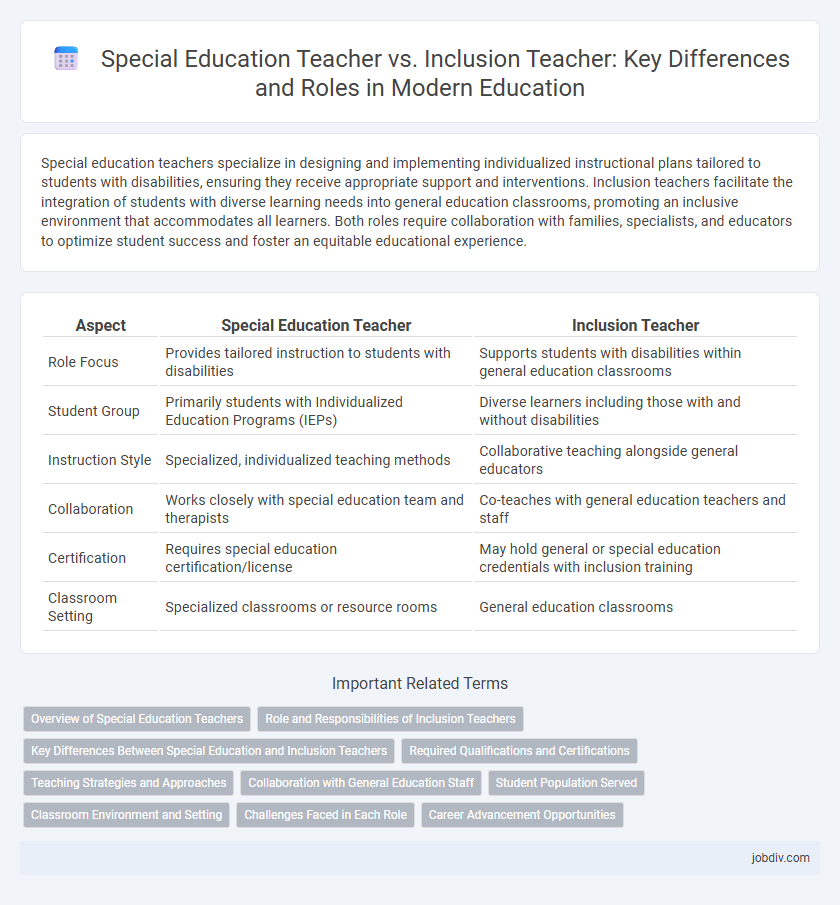Special education teachers specialize in designing and implementing individualized instructional plans tailored to students with disabilities, ensuring they receive appropriate support and interventions. Inclusion teachers facilitate the integration of students with diverse learning needs into general education classrooms, promoting an inclusive environment that accommodates all learners. Both roles require collaboration with families, specialists, and educators to optimize student success and foster an equitable educational experience.
Table of Comparison
| Aspect | Special Education Teacher | Inclusion Teacher |
|---|---|---|
| Role Focus | Provides tailored instruction to students with disabilities | Supports students with disabilities within general education classrooms |
| Student Group | Primarily students with Individualized Education Programs (IEPs) | Diverse learners including those with and without disabilities |
| Instruction Style | Specialized, individualized teaching methods | Collaborative teaching alongside general educators |
| Collaboration | Works closely with special education team and therapists | Co-teaches with general education teachers and staff |
| Certification | Requires special education certification/license | May hold general or special education credentials with inclusion training |
| Classroom Setting | Specialized classrooms or resource rooms | General education classrooms |
Overview of Special Education Teachers
Special education teachers specialize in designing and implementing individualized education programs (IEPs) to support students with disabilities, ensuring tailored instructional strategies and accommodations. They collaborate with multidisciplinary teams, including speech therapists, occupational therapists, and psychologists, to address diverse learning needs and promote student development. Special education teachers monitor progress closely and adapt teaching methods to enhance skill acquisition and academic success for students with physical, cognitive, or emotional challenges.
Role and Responsibilities of Inclusion Teachers
Inclusion teachers play a critical role in integrating students with diverse learning needs into general education classrooms, ensuring all students receive equitable access to the curriculum. They collaborate closely with special education teachers, general educators, and support staff to modify instruction and provide accommodations tailored to each student's Individualized Education Program (IEP). Their responsibilities include fostering a supportive environment that promotes social interaction and academic success for students with disabilities alongside their peers.
Key Differences Between Special Education and Inclusion Teachers
Special education teachers specialize in developing individualized education programs (IEPs) tailored to students with disabilities, focusing on specialized instruction and support within or outside the general classroom. Inclusion teachers work primarily within mainstream classrooms, adapting curriculum and teaching strategies to accommodate students with diverse learning needs alongside their peers. Key differences lie in the scope of instructional settings and the degree of integration, with special education teachers providing targeted interventions and inclusion teachers facilitating collaborative, inclusive learning environments.
Required Qualifications and Certifications
Special Education Teachers require a bachelor's degree in special education or a related field, along with state-specific teacher certification and often additional endorsements in special education. Inclusion Teachers typically need a general education teaching license with specialized training or certification in inclusive teaching practices. Both roles may require ongoing professional development and adherence to Individualized Education Program (IEP) standards to effectively support diverse learners.
Teaching Strategies and Approaches
Special Education Teachers employ individualized teaching strategies such as differentiated instruction, behavior management plans, and assistive technology to address diverse learning needs and disabilities. Inclusion Teachers utilize collaborative approaches that integrate students with special needs into general education classrooms, emphasizing co-teaching models, universal design for learning (UDL), and peer-mediated interventions. Both roles prioritize adaptive teaching methods but differ in setting focus: Special Education Teachers often work in specialized environments, while Inclusion Teachers promote inclusive practices within mainstream classrooms.
Collaboration with General Education Staff
Special education teachers collaborate closely with general education staff to develop individualized education plans (IEPs) and adapt curriculum materials for students with disabilities. Inclusion teachers work within the general classroom setting to provide differentiated instruction and behavioral support alongside general educators. Effective teamwork between these professionals enhances student participation, academic achievement, and social integration ininclusive environments.
Student Population Served
Special education teachers primarily serve students with identified disabilities requiring individualized instruction and specialized support to address various learning, emotional, or physical challenges. Inclusion teachers work with both students with disabilities and their general education peers within a mainstream classroom, promoting collaborative learning environments that accommodate diverse needs. The student population served by special education teachers is more specifically defined by formal diagnosis, while inclusion teachers support a broader range of learners through differentiated instruction.
Classroom Environment and Setting
Special education teachers typically work in specialized classrooms designed to support students with diverse learning needs through individualized instruction and adaptive resources. Inclusion teachers facilitate learning within general education classrooms, promoting collaborative environments where students with and without disabilities engage together. Both roles require tailored classroom settings to optimize accessibility, engagement, and academic outcomes for all students.
Challenges Faced in Each Role
Special education teachers frequently face challenges managing diverse learning disabilities while adapting individualized education plans (IEPs) to meet each student's unique needs effectively. Inclusion teachers often struggle with balancing the curriculum to support both general education students and those requiring additional accommodations, making classroom management complex. Both roles demand extensive collaboration with support staff and families to address behavioral issues and promote inclusive learning environments.
Career Advancement Opportunities
Special education teachers often have specialized certifications that open pathways to roles such as special education coordinators or behavioral specialists, enhancing career advancement opportunities. Inclusion teachers, skilled in adaptive strategies across diverse classrooms, can progress to leadership positions like curriculum developers or inclusion specialists within general education settings. Both roles demand continuous professional development, with career growth driven by expertise in individualized instruction and collaborative teaching methods.
Special Education Teacher vs Inclusion Teacher Infographic

 jobdiv.com
jobdiv.com